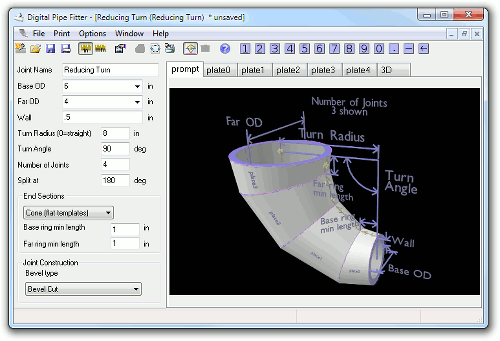Reducing Turn is like a Segmented Turn Joint except the two ends can be different diameters. Because the result is usually constructed of one or more cone shaped components, the assumption is that the components will be rolled from flat materials.
The two end components can either be rolled cone shaped, rolled cylindrical shaped, or made from pipe. Templates are generated for each of the components. Be careful to use the templates appropriately, templates are either for flat stock or wrapped around a pipe as specified in the End Sections parameter.
Parameters:
Joint Name: name of this joint which is unique to this project or currently opened joints
Base OD: diameter of the end if the joint associated with the pipe0 or plate0 component.
Far OD: diameter of the end if the joint associated with the pipex or platex component (where x is the last template in the joint).
Wall: wall thickness of all the pipes and rolled plates in the joint. This Joint does not support multiple component thicknesses in one Joint.
Run: length of rolling offset. If End Sections is set to Cone, then this is the overall length of the joint as measured from be Base opening to the Far opening. If End Sections is set to Pipe or Rolled Pipe, this measurement is from the midpoint of the seams that joint to the end pipes.
Set: height of rolling offset, centerline to centerline of the ends
Roll: width of rolling offset, centerline to centerline of the ends
Number of Joints: the number of seams to make this joint. Add one to this number to get the total number of templates generated.
Split at: locate the seam of the template at this number of degrees around the template from the axis. (default 180) This feature is useful when selecting the most efficient layout of the flat stock material.
End Sections:
- Cone (flat templates): The end sections taper at the same rate as the intermediate sections. Templates are to be used on flat material before rolling. The Run setting specifies overall length of the joint from Base OD to Far OD points.
- Rolled Pipe (flat templates): The end sections are straight sections that will be rolled to form pipes with the proper end cut to miter to the intermediate components. Templates are to be used on flat material before rolling. The Run setting specifies length of the joint from the first miter cut to the last.
- Pipe (wrapped templates): The end sections are straight sections that will be cut from standard pipe. Templates are to be used like a normal pipe template which wrap around the pipe. The Run setting specifies length of the joint from the first miter cut to the last.
The end ring component must be a complete ring in order to provide a round end to attach to another pipe. Parameters are provide to specify how long those end sections should be. If the initial calculation for the end component length is greater than the length specified, these parameters are not used. These parameters specify minimum length so that the components are long enough to weld to the adjacent component. Leave these set to zero unless you need longer end sections.
Base ring min length: the minimum allowable length of the base end section as measured along the axis of that component. Must be greater than or equal to zero.
Far ring min length: the minimum allowable length of the far end section as measured along the axis of that component. Must be greater than or equal to zero.

